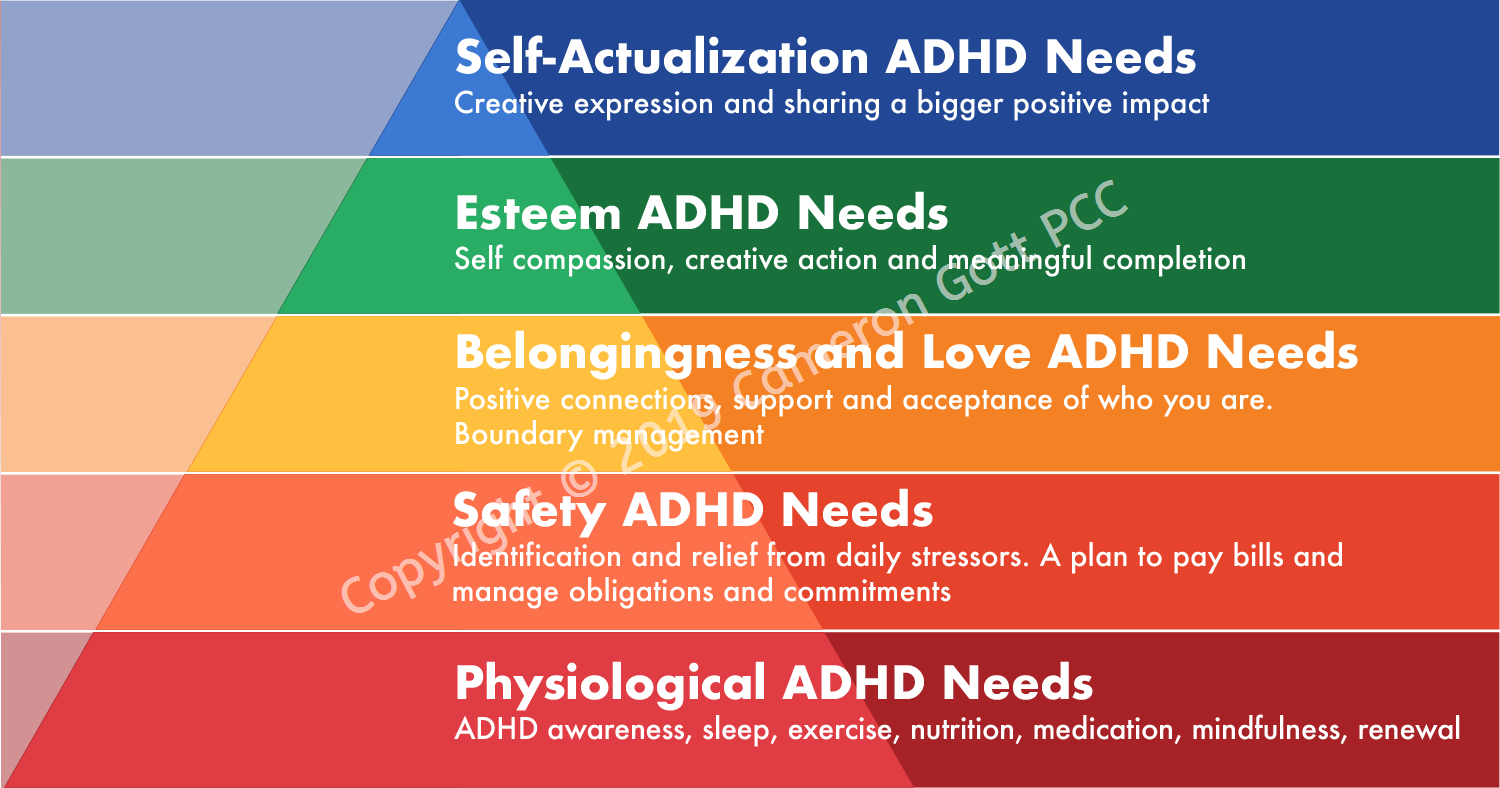Cam Gott’s Hierarchy of ADHD Needs
Adapted from Maslow’s Hierarchy of Needs
Often individuals attempt to manage their ADHD by first trying to mitigate symptoms like distractibility and impulsivity. Focusing on identifying and attending to a hierarchy of ADHD needs is a more proactive way to manage ADHD and have a bigger impact. The following diagram illustrates some examples of needs unique to the ADHD individual.
This hierarchy of ADHD needs is not a substitute for the original Maslow’s Hierarchy of Needs. Rather, it is designed to augment the original work. With respect to Maslow's somewhat dated model, one needs to satisfy a lower order need before one can start resolving the next need on the hierarchy. More recently this aspect of the hierarchy has been criticized as being overly simplistic and life turns out to be a lot more complex and organic. Also, people will generally seek out human connection regardless of the level of the hierarchy they are on. In my work with my clients, and my own efforts, I find that it is extremely difficult to succeed in the higher levels, especially with regard to a sustained positive impact when lower levels of the model are not actively addressed or ignored. Global Creatives can find it challenging to engage the more mundane, less exciting self-care aspects of the model like sleep and exercise. Be sure to review the context section below the chart. Here I further distinguish specific ADHD Needs like positive connections and environment.
Pondering your own specific needs for each level can be a useful exercise. On a scale of 1-5 how would you evaluate yourself for each level? This exercise is similar to the Wheel of Life exercise popular in coaching circles. Orienting oneself to a model can establish some perspective and some worthwhile goals to aim for.
Copyright © 2019 Cameron Gott PCC
CONTEXT
Physiological ADHD Needs
ADHD needs start with basic brain management and basic brain awareness - an understanding of how your ADHD uniquely impacts and enhances you and your world. ADHD inhibits our ability to generate accurate awareness often coloring or distorting our experience. Do you know your unique ADHD blindspots? What is your unique combination of needs for optimal physiological functioning?
Safety ADHD Needs
Living from crisis to crisis creates a mounting stress load that becomes untenable. Your limbic system needs an occasional break. Those of us with ADHD can be overly reliant on stress as a way to get things done. Stress management - identify those repetitive items that create stress and hatch a plan to address head on. Avoidance and procrastination are not your friends here.
Belongingness and Love ADHD Needs
ADHD can have an isolating effect. Furthermore, you can often feel like you have to be inauthentic to be socially accepted. Getting to be who you are and being accepted has a healing effect. Boundary management can be a challenge but with practice you can have healthier relationships.
Esteem ADHD Needs
ADHD disrupts action but to have a sense of accomplishment you have to accomplish. To accomplish (and finish) you have to do. To do you have to prioritize and start. Practicing in areas of strength is a place to begin. Positive support structures are key like accountability partners. Furthermore, challenging your own ‘Inner-Critic’ and their biting commentary is essential to fostering sense of self and identify. Personal core value identification is a good practice. Separating and distinguishing who you are from your last accomplishment is key too. Accomplish but also recognize your own intrinsic value, your sense of self and be OK with somedays or moments when accomplishing is not in the cards.
Self-Actualization ADHD Needs
Having a bigger impact lives here. People with ADHD are wired for context – a sense of connection to something meaningful and bigger than the self. To be ADHD is to be creative and expressive. You need not be the loudest to have a big impact. Addressing the lower needs sets you up for success at this level.

